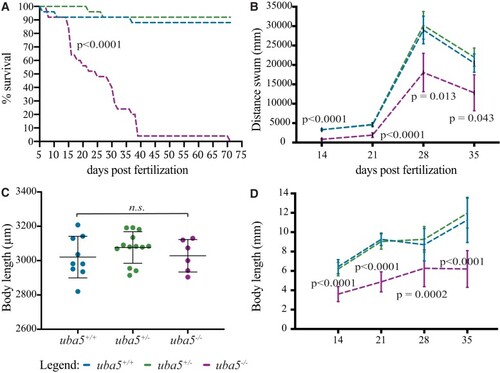
Survival, motor function and growth are impaired in uba5ex1s/ex1s fish. (A) 25 uba5+/+, 25 uba5+/ex1s and 25 uba5ex1s/ex1s embryos were raised, and their survival was analysed. (B) Quantification of the distance travelled showed a significant reduction of the motor function in uba5ex1s/ex1s compared to wild-type siblings. Data are represented as mean ± SD predicted by the linear model statistical test for one biological replicate analysed at 14 (n = 23 uba5+/+; n = 25 uba5+/ex1s; n = 23 uba5ex1s/ex1s), 21 (n = 23 uba5+/+; n = 25 uba5+/ex1s; n = 14 uba5ex1s/ex1s), 28 (n = 23 uba5+/+; n = 23 uba5+/ex1s; n = 12 uba5ex1s/ex1s) and 35 dpf (n = 23 uba5+/+; n = 23 uba5+/ex1s; n = 6 uba5ex1s/ex1s). (C) Measurement of the body length at 5 dpf did not reveal a significant difference between uba5ex1s/ex1s and wild-type siblings (n = 9 uba5+/+; n = 13 uba5ex1s/+; n = 6 uba5ex1s/ex1s). Each dot represents an individual zebrafish. The error bars represent mean ± SD for one biological replicate. n.s., non-significant using a one-way ANOVA. (D) Measurement of the body length at 14 (n = 23 uba5+/+; n = 25 uba5+/ex1s; n = 23 uba5ex1s/ex1s), 21 (n = 21* uba5+/+; n = 25 uba5+/ex1x; n = 14 uba5ex1s/ex1s), 28 (n = 23 uba5+/+; n = 21* uba5+/ex1s; n = 12 uba5ex1s/ex1s) and 35 dpf (n = 23 uba5+/+; n = 23 uba5+/ex1s; n = 5* uba5ex1s/ex1s) demonstrates that uba5ex1s/ex1s are smaller than wild-type siblings at later stages of development. Data are represented as mean ± SD predicted by the linear model statistical test. *These numbers were originally the same as in (B), but we were unable to measure the body length of some fish, and therefore, these were not included in the analysis.
|

